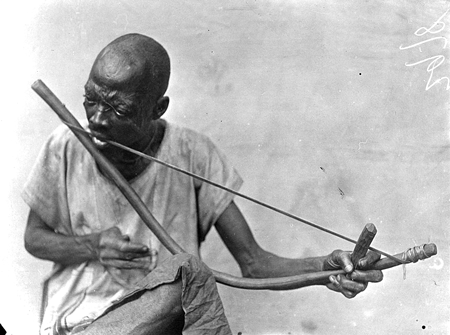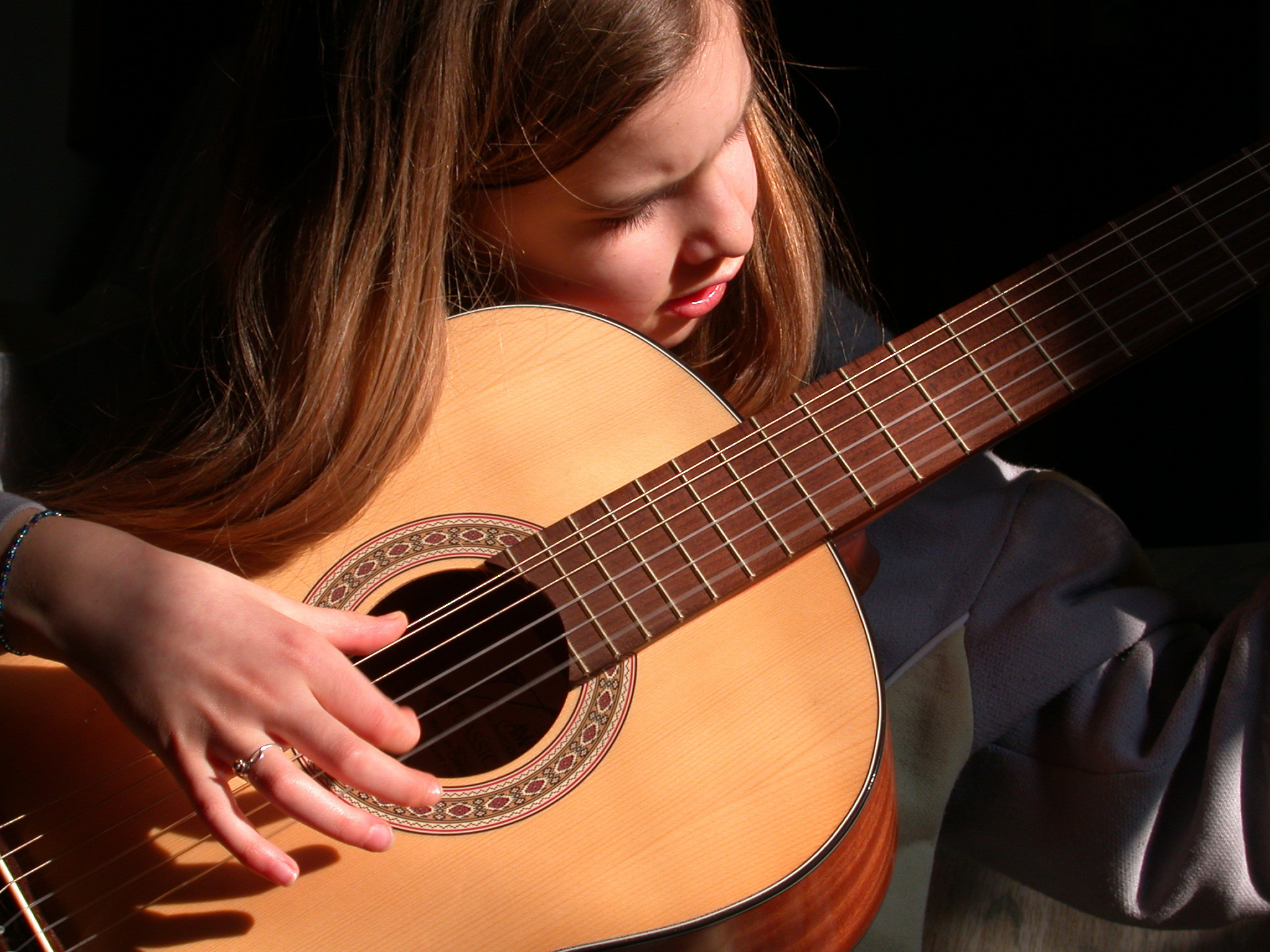|
Ahardin
Ahardin is a musical bow played by southern Tuaregs consists of a curved branch held with a twisted rope of raw leather or bark of acacia. Serving as a sound box, a reversed calabash is placed on the curved part of the bow on the ground. To hold the whole, the player presses her knee on the container. With the fingers of the left hand, as with the imzad, she defines the melody, while with the thumb and forefinger of the right hand, she grip the string with a regular gesture vibrate. At present, the ahardin, an instrument whose manufacture is easily improvised, is considered above all as a game of girls. Tahardant, feminine of ahardin, is also the name of a plucked string instrument, a kind of guitar played throughout the region of the Niger River loop, by "court craftsmen" in the Tuaregs and by griot A griot (; ; Manding languages, Manding: or (in N'Ko script, N'Ko: , or in French spelling); also spelt Djali; or / ; ) is a West African historian, storyteller, praise si ... [...More Info...] [...Related Items...] OR: [Wikipedia] [Google] [Baidu] |
String Instrument
In musical instrument classification, string instruments, or chordophones, are musical instruments that produce sound from vibrating strings when a performer strums, plucks, strikes or sounds the strings in varying manners. Musicians play some string instruments, like Guitar, guitars, by plucking the String (music), strings with their fingers or a plectrum, plectrum (pick), and others by hitting the strings with a light wooden hammer or by rubbing the strings with a bow (music), bow, like Violin, violins. In some keyboard (music), keyboard instruments, such as the harpsichord, the musician presses a key that plucks the string. Other musical instruments generate sound by striking the string. With bowed instruments, the player pulls a rosined horsehair bow across the strings, causing them to vibrate. With a hurdy-gurdy, the musician cranks a wheel whose rosined edge touches the strings. Bowed instruments include the string section instruments of the orchestra in Western classic ... [...More Info...] [...Related Items...] OR: [Wikipedia] [Google] [Baidu] |
Musical Bow
The musical bow (bowstring or string bow, a subset of bar zithers) is a simple string instrument used by a number of African peoples as well as Indigenous peoples of the Americas. It consists of a flexible, usually wooden, stick 1.5 to 10 feet (0.5 to 3 m) long, and strung end to end with a taut cord, usually metal. It can be played with the hands or a wooden stick or branch. It is uncertain if the musical bow developed from the hunting bow, though the San or Bushmen people of the Kalahari Desert do convert their hunting bows to musical use. Types of bow include mouth-resonated string bow, earth-resonated string bow, and gourd-resonated string bow. History There is speculation that the hunting bow may have been used as a musical instrument from as early as circa 13,000 B.C. Henri Breuil surveyed the Trois Frères in France caves and made an engraving that attempted to reproduce a c. 13,000 B.C. cave painting into a black-and-white lithograph engraving. His engra ... [...More Info...] [...Related Items...] OR: [Wikipedia] [Google] [Baidu] |
Tuareg People
The Tuareg people (; also spelled Twareg or Touareg; Endonym and exonym, endonym, depending on Tuareg languages#Subclassification, variety: ''Imuhaɣ'', ''Imušaɣ'', ''Imašeɣăn'' or ''Imajeɣăn'') are a large Berbers, Berber ethnic group, traditionally nomadic pastoralism, pastoralists, who principally inhabit the Sahara in a vast area stretching from far southwestern Libya to southern Algeria, Niger, Mali, Burkina Faso, and as far as northern Nigeria, with small communities in Chad and Sudan known as the ''Kinnin''. The Tuareg speak Tuareg languages, languages of the same name, also known as ''Tamasheq'', which belong to the Berber languages, Berber branch of the Afroasiatic family. They are a semi-nomadic people who mostly practice Islam, and are descended from the indigenous Berber communities of Northern Africa, whose ancestry has been described as a mosaic of local North Africa, Northern African (Taforalt), Middle Eastern, Genetic history of Europe, European (Early Eu ... [...More Info...] [...Related Items...] OR: [Wikipedia] [Google] [Baidu] |
Sound Box
A sound box or sounding box (sometimes written soundbox) is an open chamber in the body of a musical instrument which modifies the sound of the instrument, and helps transfer that sound to the surrounding air. Objects respond more strongly to vibrations at certain frequencies, known as resonances. The frequency and strength of the resonances of the body of a musical instrument have a significant impact on the tone quality it produces. The air inside the chamber has its own resonances, and these interact with the resonances of the body, altering the resonances of the instrument as a whole. The sound box typically adds resonances at lower frequencies, enhancing the lower-frequency response of the instrument. The distinctive sound of an instrument with a sound box owes a lot to the alteration made to the tone. A sound box is found in most string instruments. The most notable exceptions are some electrically amplified instruments like the solid body electric guitar or the electric vio ... [...More Info...] [...Related Items...] OR: [Wikipedia] [Google] [Baidu] |
Imzad
The imzad (; alternately amzad) is a type of bowed "single-string fiddle" used by the Tuareg people, Tuareg people in Africa. Its body is made out of a gourd which is covered by animal skin, creating a soundboard (music), soundboard. The strings are made from horse hair and are connected near the neck, and runs over a two-part bridge. The bridge is made of two pieced of wood, joined into a cross. The round bow is also equipped with horse hair. Traditionally, the instrument was played to accompany men's songs. The imzad is only played by the women for example to accompany songs, often during an evening ceremony called ''takket''. References External links * Project page "Sauver l'imzad" with images and music examples {{Authority control One-string fiddles Tuareg musical instruments Bowed string instruments ... [...More Info...] [...Related Items...] OR: [Wikipedia] [Google] [Baidu] |
Encyclopédie Berbère
''Encyclopédie berbère'' (English: ''Berber Encyclopaedia'') is a French-language encyclopaedia dealing with subjects related to the Berber peoples (''Imazighen'' in Berber language), published both in print editions and in a partial online version. It was launched in 1984 under the aegis of UNESCO and was originally published by Editions Edisud. Its first editor-in-chief was Gabriel Camps. After his death in 2002, he was succeeded by Salem Chaker, Professor of Berber languages at the Aix-Marseille University Aix-Marseille University (AMU; ; formally incorporated as ) is a Public university, public research university located in the Provence region of southern France. It was founded in 1409 when Louis II of Anjou, List of rulers of Provence, Count of .... Up to 2013, volumes 1 to 36 (Oryx - Ozoutae) have been published online through OpenEdition.org. The online site allows part of the encyclopedia to be viewed in full text and in PDF and offers a search function to key ... [...More Info...] [...Related Items...] OR: [Wikipedia] [Google] [Baidu] |
Griot
A griot (; ; Manding languages, Manding: or (in N'Ko script, N'Ko: , or in French spelling); also spelt Djali; or / ; ) is a West African historian, storyteller, praise singer, poet, and/or musician. Griots are masters of communicating stories and history orally, which is an African tradition. Instead of writing history books, List of oral repositories, oral historians tell stories of the past that they have memorized. Sometimes there are families of historians, and the oral histories are passed down from one generation to the next. Telling a story out loud allows the speaker to use poetic and musical conventions that entertain an audience. This has contributed to many oral histories surviving for hundreds of years without being written down. Through their storytelling, griots preserve and pass on the values of a tribe or people, such as the Senegalese, who are Muslims. The Wolof people in Senegal, many of whom cannot read or write, depend on griots to learn abou ... [...More Info...] [...Related Items...] OR: [Wikipedia] [Google] [Baidu] |
Songhai People
The Songhai people ( autonym: Ayneha) are an ethnolinguistic group in West Africa who speak the various Songhai languages. Their history and ''lingua franca'' is linked to the Songhai Empire which dominated the western Sahel in the 15th and 16th century. Predominantly adherents of Islam, the Songhai are primarily located in Niger and Mali. Historically, the term "Songhai" did not denote an ethnic or linguistic identity but referred to the ruling caste of the Songhay Empire known as the Songhaiborai. However, the correct term used to refer to this group of people collectively by the natives is "Ayneha". Although some speakers in Mali have also adopted the name ''Songhay'' as an ethnic designation, other Songhay-speaking groups identify themselves by other ethnic terms such as Zarma (or Djerma, the largest subgroup) or Isawaghen. The dialect of Koyraboro Senni spoken in Gao is unintelligible to speakers of the Zarma dialect of Niger, according to at least one report. The Song ... [...More Info...] [...Related Items...] OR: [Wikipedia] [Google] [Baidu] |
Musical Bows , the ability to perceive music or to create music
*
{{Music disambiguation ...
Musical is the adjective of music. Musical may also refer to: * Musical theatre, a performance art that combines songs, spoken dialogue, acting and dance * Musical film and television, a genre of film and television that incorporates into the narrative songs sung by the characters * MusicAL, an Albanian television channel * Musical isomorphism, the canonical isomorphism between the tangent and cotangent bundles See also * Lists of musicals * Music (other) * Musica (other) * Musicality Musicality (''music -al -ity'') is "sensitivity to, knowledge of, or talent for music" or "the quality or state of being musical", and is used to refer to specific if vaguely defined qualities in pieces and/or genres of music, such as melodiousnes ... [...More Info...] [...Related Items...] OR: [Wikipedia] [Google] [Baidu] |




